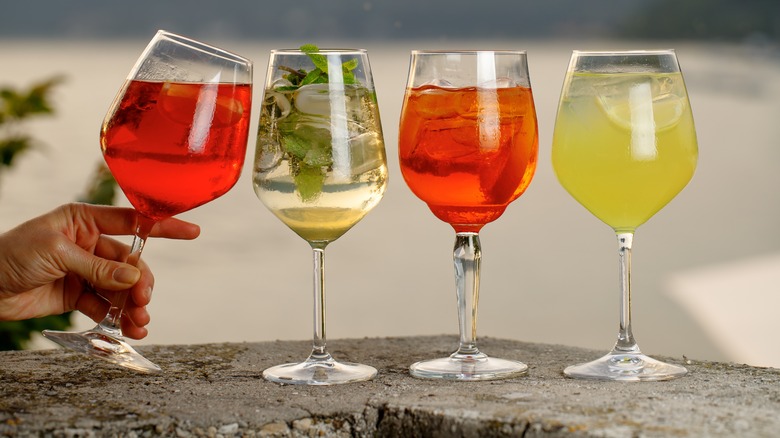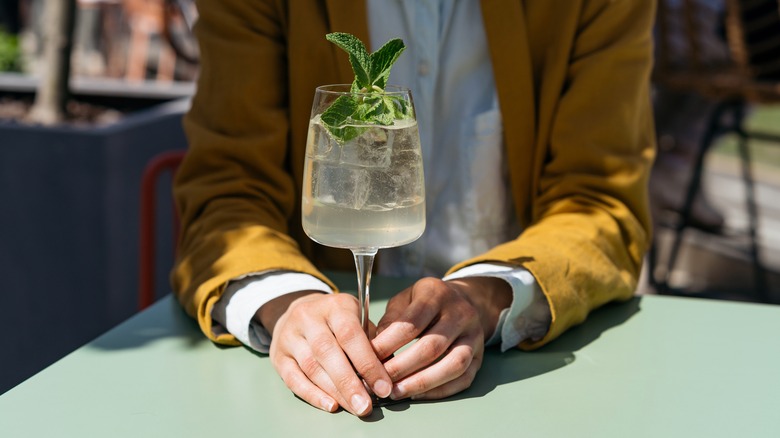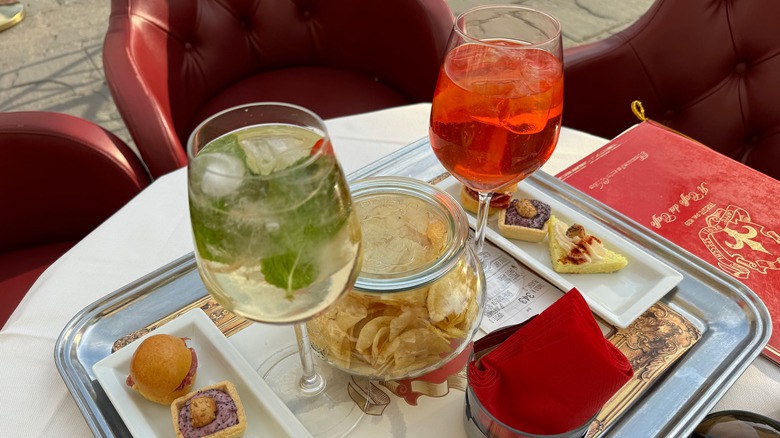The Delicious And Authentic Drink To Order In Italy If You're Not A Fan Of Aperol Spritz
When it comes to iconic Italian cocktails, the Aperol Spritz reigns supreme. The vibrant orange drink has become synonymous with summer afternoons and sunset aperitivi in Italy, its bitter-sweet flavor and effervescent bubbles making it a popular choice among locals and tourists alike. Aperitivo, the Italian equivalent of happy hour, is a quintessential pre-dinner ritual that involves sipping delicious drinks and nibbling on light snacks (however, locals will side-eye you if you order a spritz with lunch or dinner). While the Aperol Spritz is perhaps the most famous aperitivo option, not everyone is a fan of its distinctive bitterness. For those who prefer something a little lighter and more refreshing, there's a new alternative cocktail on the block: the Hugo Spritz.
@ciarainitaly If you don't like Aperol Spritz, get this drink instead 🥂 🇮🇹#CapCut #hugospritz #aperolspritz #spriz #summerdrink #italiandrinks #summerinitaly #aperitivo #aperitivobologna #aperitivoitaly #irishinitaly #italianlife
Spritzes originated in Italy's Veneto region in the 19th century, when people used to add sparkling water to their wine. Today, there are endless variations of the spritz. The Hugo Spritz, or simply Hugo (pronounced "ugo"), a lesser-known but equally authentic Italian cocktail, has been gaining popularity on the aperitivo scene in recent years. Originating in the early 2000s in the South Tyrol region (Alto Adige or Südtirol) of Northern Italy, the Hugo offers a floral, slightly sweet flavor profile that makes it an ideal choice for anyone who finds the Aperol Spritz a bit too intense — in bitterness, alcohol, and sugar content. Let's explore the history, ingredients, and reasons why the Hugo Spritz should be your go-to drink the next time you find yourself in Italy.
What is a Hugo Spritz?
Hugo Spritz was created in 2005 by maestro bartender Roland Gruber, a South Tyrol native known locally as "Ak," at his wine and cocktail bar Sanzeno, which you can visit if you go to Naturno. Situated in the Italian Alps, South Tyrol is known for its stunning landscapes, blend of Italian and Austrian cultures, and passion for good food and drink (that might make you break out in yodels!). South Tyrol also has one of Rick Steve's favorite mountain towns, which is an absolute hidden gem.
The Hugo is easy to make, with just a few ingredients needed to create its refreshing, delicate, floral flavor — not too boozy, yet not too gentle, not too sweet, yet not too dry or sour. Gruber's classic original recipe calls for elderflower syrup or liqueur (like St. Germain or Fiorente), sparkling wine or prosecco, soda water, fresh mint leaves, and a lime wedge. The result is an ideal drink for warm weather that pairs wonderfully with a variety of aperitivo snacks.
What renders the Hugo its unique flavor profile is elderflower ("fiori di sambuco"), the spritz's key ingredient. Made from the delicate white flowers of the elderberry plant, elderflower adds a subtle sweetness to the drink without overpowering it. This plant is native to the Italian Alps and blooms there from mid-May until June. Elderflower is steeped in Alpine folklore and is believed to ward off evil spirits. The region's influence on the drink can literally be tasted.
Enjoying the Hugo Spritz in Italy, and bringing it back home
You'll find that the Hugo Spritz is a popular choice at many bars and cafes, especially in the northern regions of Italy. However, its popularity has spread throughout the country, and it's often featured on the menu, especially during the warmer months. When ordering, the bartender or server may ask if you prefer it with elderflower syrup or liqueur — both are great; your choice only depends on how sweet or strong you like it.
Although you can enjoy a Hugo any time of the day, it's typically enjoyed during aperitivo hour — which is, by the way, a secret to cheaper alcohol. Have it with aperitivo snacks known as "cicchetti" or "stuzzichini." These small, flavorful bites range from olives and nuts to elaborate spreads of charcuterie. Pair the cocktail with meats like prosciutto crudo or mortadella veroni, fish finger foods, and cheeses such as mozzarella, crescenza, and robiola.
Even if you're not in Italy (or lucky enough to try it at its birth bar of Sanzeno), you can still enjoy a Hugo Spritz at home. To make it, fill a tall wine glass with ice, add about 1 or 2 ounces of elderflower syrup or liqueur, and top it with ⅔ cup of chilled prosecco. Add a splash of soda water, stir gently, and garnish with a sprig of fresh mint and a lime wedge. If you want a sweeter drink, follow a standard 3:2:1 Spritz ratio. Cin-cin!


